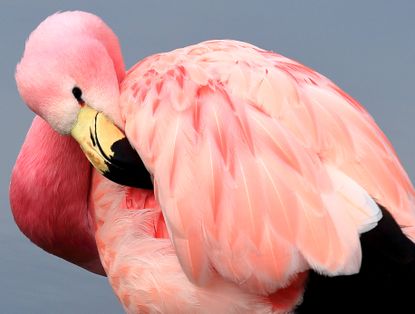Scientists may have finally figured out how flamingos can stand on one leg, not fall over

For flamingos, standing on one leg might actually be easier than standing on two. A report published Wednesday in The Royal Society's Biology Letters revealed that flamingos might literally be built to stand on one leg, which would explain how they're able to do so while they sleep without toppling over.
When the researchers' first idea for testing flamingos' balance — walking over to the birds in a zoo and giving them "a little prod" — was rejected, they turned to studying flamingo cadavers. To their surprise, they found that while a dead flamingo can't stand on two legs, it can still balance on one. When the researchers began studying live flamingos — by watching them until the birds dozed off — they found out flamingos' balance became better as they fell asleep.
That led researchers to realize that flamingos' fantastic balance might have something to do with their anatomy, specifically a built-in "stay mechanism." The Washington Post explained the phenomenon:
Subscribe to The Week
Escape your echo chamber. Get the facts behind the news, plus analysis from multiple perspectives.

Sign up for The Week's Free Newsletters
From our morning news briefing to a weekly Good News Newsletter, get the best of The Week delivered directly to your inbox.
From our morning news briefing to a weekly Good News Newsletter, get the best of The Week delivered directly to your inbox.
The bird's skeleton appears to be the key. As with humans, flamingos have two main joints on their leg. The one you can see, that bends backward, is not the knee. That's actually the bird’s ankle. Its knee, meanwhile, is hidden in the bird's features at the fatter part of its body.When the flamingo is ready to nod off, it lifts one leg and instinctively moves its body so its single foot isn't under its hip. Instead, it's centered directly under the carriage of bird. Meanwhile, pulling the other leg up forces the knee to bend, which the flamingo rests on. All the joints essentially snap into place.[...] As the flamingo remains nearly perfectly still while sleeping, gravity does the rest, keeping the bird in place. [The Washington Post]
Though the researchers might be one step closer to figuring out how flamingos stand on one leg, the question of why they do so remains a mystery. Flamingo studier Matt Anderson, of St. Joseph's University, pointed out to The Atlantic that if standing on one leg saved flamingos so much energy, "one would expect flamingos to employ the one-legged resting stance constantly."
Create an account with the same email registered to your subscription to unlock access.
Sign up for Today's Best Articles in your inbox
A free daily email with the biggest news stories of the day – and the best features from TheWeek.com
-
 'A speaker courageous enough to stand up to the extremists in his own party'
'A speaker courageous enough to stand up to the extremists in his own party'Instant Opinion Opinion, comment and editorials of the day
By Harold Maass, The Week US Published
-
 How could the Supreme Court's Fischer v. US case impact the other Jan 6. trials including Trump's?
How could the Supreme Court's Fischer v. US case impact the other Jan 6. trials including Trump's?Today's Big Question A former Pennsylvania cop might hold the key to a major upheaval in how the courts treat the Capitol riot — and its alleged instigator
By Rafi Schwartz, The Week US Published
-
 Today's political cartoons - April 18, 2024
Today's political cartoons - April 18, 2024Cartoons Thursday's cartoons - impeachment Peanuts, record-breaking temperatures, and more
By The Week US Published
-
 Blind people will listen to next week's total eclipse
Blind people will listen to next week's total eclipseSpeed Read While they can't see the event, they can hear it with a device that translates the sky's brightness into music
By Peter Weber, The Week US Published
-
 Melting polar ice is messing with global timekeeping
Melting polar ice is messing with global timekeepingSpeed Read Ice loss caused by climate change is slowing the Earth's rotation
By Peter Weber, The Week US Published
-
 An amphibian that produces milk?
An amphibian that produces milk?speed read Caecilians, worm-like amphibians that live underground, produce a milk-like substance for their hatchlings
By Peter Weber, The Week US Published
-
 Jupiter's Europa has less oxygen than hoped
Jupiter's Europa has less oxygen than hopedspeed read Scientists say this makes it less likely that Jupiter's moon harbors life
By Peter Weber, The Week US Published
-
 Why February 29 is a leap day
Why February 29 is a leap daySpeed Read It all started with Julius Caesar
By Peter Weber, The Week US Published
-
 US spacecraft nearing first private lunar landing
US spacecraft nearing first private lunar landingSpeed Read If touchdown is successful, it will be the first U.S. mission to the moon since 1972
By Peter Weber, The Week US Published
-
 Scientists create 'meaty' rice for eco-friendly protein
Scientists create 'meaty' rice for eco-friendly proteinSpeed Read Korean scientists have invented a new hybrid food, consisting of beef muscle and fat cells grown inside grains of rice
By Peter Weber, The Week US Published
-
 Race to the Moon: the manned missions to lunar surface
Race to the Moon: the manned missions to lunar surfaceThe Explainer China and US locked in battle for future dominance of Earth's satellite and its precious resources
By Harriet Marsden, The Week UK Published